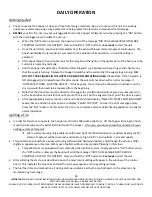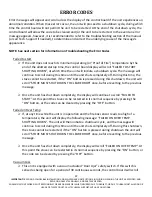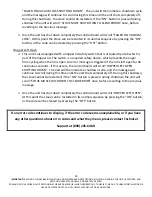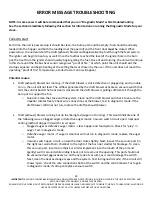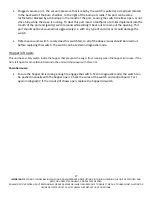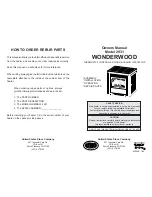
15
IMPORTANT!
READ
AND
FOLLOW
ALL
INSTALLATION
AND
MAINTENANCE
INSTRUCTIONS,
INCLUDING
CLEANING
THE
UNIT
AS
SPECIFIED,
AND
REPLACING
GASKETS
ANNUALLY,
AND
PARTS
AS
NEEDED.
ENGLAND’S
STOVE
WORKS
IS
NOT
RESPONSIBLE
FOR
ANY
DAMAGE
OR
INJURY
INCURRED
DUE
TO
NEGLECT,
OR
DUE
TO
UNSAFE
INSTALLATION
OR
USAGE
OF
THIS
PRODUCT.
CALL
TECHNICAL
SUPPORT
WITH
ANY
QUESTIONS.
VENT
TERMINATION
CLEARANCES
A)
Min.
4
‐
ft
clearance
below
or
beside
any
door
or
window
that
opens.
B)
Min.
1
‐
ft
clearance
above
any
door
or
window
that
opens.
C)
Min.
2
‐
ft
clearance
from
any
adjacent
building.
D)
Min.
7
‐
ft
clearance
from
any
grade
when
adjacent
to
public
walkways.
E)
Min.
2
‐
ft
clearance
above
any
grass,
plants,
or
other
combustible
materials.
F)
Min.
3
‐
ft
clearance
from
a
forced
air
intake
of
any
appliance.
G)
Min.
2
‐
ft
clearance
below
eaves
or
overhang.
H)
Min.
1
‐
ft
clearance
horizontally
from
combustible
wall.
I)
Vents
installed
with
mechanical
exhausters
shall
terminate
not
less
than
12
in.
(305mm)
above
the
highest
point
where
they
pass
through
the
roof
surface.
Notes
on
termination
of
Pellet
Vent
Pipe
from
NFPA
211
(2006
ed.)
Section
10.4
Termination:
10.4.5
(See
also
“INSTALLATION”
section
of
manual
AND
additional
notes
above)
:
Not
less
than
three
(3)
feet
above
any
forced
air
inlet
located
within
ten
(10)
feet.
Not
less
than
four
(4)
feet
below,
four
(4)
feet
horizontally
from,
or
one
(1)
foot
above
any
door,
window
or
gravity
air
inlet
into
any
building.
Not
less
than
two
(2)
feet
from
an
adjacent
building,
and
not
less
than
seven
(7)
feet
above
grade
where
located
adjacent
to
public
walkways.
The
exhaust
exit
shall
be
arranged
so
that
the
flue
gases
are
not
directed
so
that
it
will
affect
people,
overheat
combustible
structures,
or
enter
buildings.
Forced
draft
systems
and
all
parts
of
induced
draft
systems
under
positive
pressure
during
operation
shall
be
installed
gastight
or
to
prevent
leakage
of
combustion
products
into
a
building.
Through
‐
the
‐
wall
vents
shall
not
terminate
over
public
walkways,
or
where
condensate
or
vapor
could
create
hazards
or
a
nuisance.
Be
sure
to
follow
local
codes
and
all
manufacturer’s
instructions
(including
exhaust
pipe).
Consult
a
professional
installer
and/or
call
Technical
Support
if
you
have
any
questions.


















